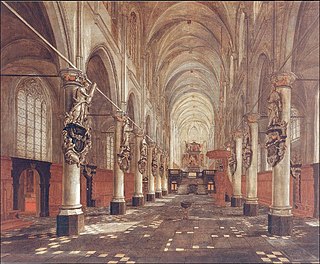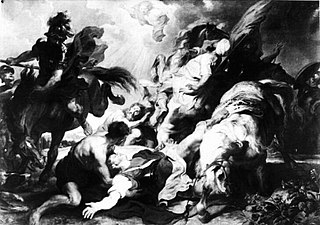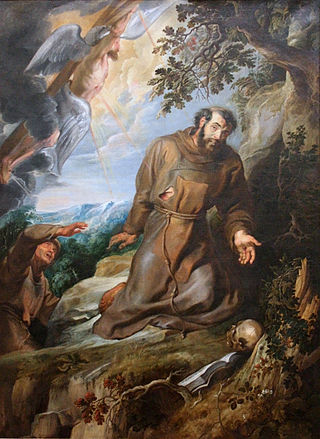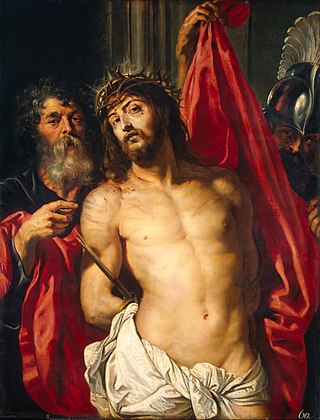
The Caravaggisti were stylistic followers of the late 16th-century Italian Baroque painter Caravaggio. His influence on the new Baroque style that eventually emerged from Mannerism was profound. Caravaggio never established a workshop as most other painters did, and thus had no school to spread his techniques. Nor did he ever set out his underlying philosophical approach to art, the psychological realism which can only be deduced from his surviving work. But it can be seen directly or indirectly in the work of Rubens, Jusepe de Ribera, Bernini, and Rembrandt. Famous while he lived, Caravaggio himself was forgotten almost immediately after his death. Many of his paintings were reascribed to his followers, such as The Taking of Christ, which was attributed to the Dutch painter Gerrit van Honthorst until 1990.

The Alte Pinakothek is an art museum located in the Kunstareal area in Munich, Germany. It is one of the oldest galleries in the world and houses a significant collection of Old Master paintings. The name Alte (Old) Pinakothek refers to the time period covered by the collection—from the fourteenth to the eighteenth century. The Neue Pinakothek, re-built in 1981, covers nineteenth-century art, and Pinakothek der Moderne, opened in 2002, exhibits modern art. All three galleries are part of the Bavarian State Painting Collections, an organization of the Free state of Bavaria.

Caravaggio created one of his most admired altarpieces, The Entombment of Christ, in 1603–1604 for the second chapel on the right in Santa Maria in Vallicella, a church built for the Oratory of Saint Philip Neri. A copy of the painting is now in the chapel, and the original is in the Vatican Pinacoteca. The painting has been copied by artists as diverse as Rubens, Fragonard, Géricault and Cézanne.

The Elevation of the Cross is the name of two paintings, a very large triptych in oil on panel and a much smaller oil on paper painting. Both pieces were painted by the Flemish artist Peter Paul Rubens in Antwerp, Belgium, the original in 1610 and the latter in 1638.

The Descent from the Cross is the central panel of a triptych painting by Peter Paul Rubens in 1612–1614. It is still in its original place, the Cathedral of Our Lady, Antwerp, Belgium, along with another great altarpiece The Elevation of the Cross. The subject was one Rubens returned to again and again in his career. This particular work was commissioned on September 7, 1611, by the Confraternity of the Arquebusiers, whose Patron Saint was St. Christopher.

Artus Wolffort, Artus Wolffaert or Artus Wolffaerts (1581–1641) was a Flemish painter known mainly for his history paintings depicting religious and mythological scenes.

The "National Museum of Sculpture" is a museum in Valladolid, Spain, belonging to the Spanish Ministry of Culture. The museum has an extensive sculptural collection ranging from the Middle Ages to the 19th century. The collections come mostly from churches and monasteries in the Region of Castile, whose pieces of religious art were confiscated by the State in 1836, by order of Minister of Finance Mendizábal. Other parts of the collections come from particular donations, deposits or acquisitions by the State.

Sir Peter Paul Rubens was a Flemish artist and diplomat from the Duchy of Brabant in the Southern Netherlands. He is considered the most influential artist of the Flemish Baroque tradition. Rubens's highly charged compositions reference erudite aspects of classical and Christian history. His unique and immensely popular Baroque style emphasized movement, colour, and sensuality, which followed the immediate, dramatic artistic style promoted in the Counter-Reformation. Rubens was a painter producing altarpieces, portraits, landscapes, and history paintings of mythological and allegorical subjects. He was also a prolific designer of cartoons for the Flemish tapestry workshops and of frontispieces for the publishers in Antwerp.

St Sebastian is a painting of c. 1614 by Peter Paul Rubens, showing the Christian Saint Sebastian. It dates to the early years of Rubens' stay in Rome - its sinuous line and defined figures are thought to be the result of his studies of Michelangelo and of Flemish Mannerism. It was bought by the Borghese directly from cardinal Neri Corsini in Brussels. It is now in the Borghese collection.

The Last Supper (1630–1631) is an oil painting by Peter Paul Rubens. It was commissioned by Catherine Lescuyer as a commemorative piece for her father. Rubens created it as part of an altarpiece in the Church of St. Rombout (Rumbold) in Mechelen. The painting depicts Jesus and the Apostles during the Last Supper, with Judas dressed in blue turning back towards the viewer and away from the table. Other than Jesus, the most prominent figure is Judas. Judas holds his right hand to his mouth with his eyes avoiding direct contact with the other figures in the painting creating a nervous expression. Jesus is dressed in red and has a yellow halo surrounding his head with his face tilted upwards. Jesus is located centrally in the painting surrounded by his disciples with six on each side, and he holds a loaf of bread with a cup of wine in front of him. Out of all of the figures, he is the most in the light with the figures to the farthest left being the most in shadow. “The scene thus represents a perfect conflation of the theological significance of the Last Supper” meaning the conflation between the blessing of the bread and the wine while still being pivotal in the sense of revealing the betrayal.

Christ Giving the Keys to St. Peter is a painting by the Flemish artist Peter Paul Rubens, completed in 1614. It is now in the Gemäldegalerie in Berlin.

The Resurrection of Christ is a 1611-1612 triptych painting by Peter Paul Rubens, now in the Cathedral of Our Lady in Antwerp.

Christ Appointing Saint Roch as Patron Saint of Plague Victims or The Plague Victims is a 1623–1626 altarpiece by Peter Paul Rubens. It is located in the Sint-Martinuskerk in Aalst, Belgium and depicts Saint Roch.

The Defeat of Sennacherib is an oil-on-panel painting by Peter Paul Rubens, now in the Alte Pinakothek in Munich, produced ca.1612–1614. It shows the defeat of the army of Sennacherib by an angel, as described in 2 Kings:19. It is a pendant to The Conversion of Saint Paul, now in the Courtauld Gallery in London.

The Conversion of Saint Paul is a 1620s painting by Peter Paul Rubens, now missing or lost. It showed the conversion of Paul the Apostle.

Descent from the Cross is an oil-on-panel painting of 1600–1602 by the Flemish artist Peter Paul Rubens. It was his first major commissioned work made for the private chapel of Eleonora de’ Medici Gonzaga (1567–1611), duchess of Mantua. The painting remained somewhat obscure until 2005, when it was discovered by German art historian Justus Müller-Hofstede, a specialist on Rubens' early work.

The Tears of Saint Peter or Penitent Saint Peter is a 1580-1589 painting by El Greco, now in the Bowes Museum in Barnard Castle, UK. It shows Peter the Apostle weeping after his betrayal of Jesus.

Saint Francis Receiving the Stigmata is an oil painting on canvas by Peter Paul Rubens, produced for the Franciscan monastic church in Ghent, probably part of a commission for three works for the same church – the others were St Mary Magdalene in Ecstasy and The Virgin Mary and Saint Francis Saving the World from Christ's Anger. It measures 265.5 cm x 193 cm and has been variously dated to around 1630 and to between 1615 and 1620.

The Tribute Money is a 1612-1614 painting by Peter Paul Rubens, which has been in the Fine Arts Museum of San Francisco since 1944. It illustrates the Biblical account of Christ and the tribute money.

Ecce Homo or Christ Wearing the Crown of Thorns is an oil on oak panel painting of the Ecce Homo subject by Peter Paul Rubens, executed c. 1612, now in the Hermitage Museum, in Saint Petersburg. The Hermitage also houses an oil study for its figure of Pilate.




















